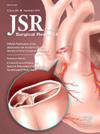Enteral and Parenteral Nutrition Timing in eICU Collaborative Research Database by Race: A Retrospective Observational Study
IF 1.7
3区 医学
Q2 SURGERY
引用次数: 0
Abstract
Introduction
Racial and ethnic disparities in malnutrition are well-known, but it is unknown if there are disparities in early nutrition delivery for intensive care unit (ICU) patients, which is associated with better outcomes. We investigated the timing of enteral nutrition (EN) and parenteral nutrition (PN) initiation in the ICU, examining for racial differences.
Methods
Using the eICU-Collaborative Research Database (eICU-CRD) from 2014 to 2015, we analyzed patients eligible for EN and PN from 208 hospitals. EN and PN delivery was captured through intake/output entries. Exclusions included pre-existing EN/PN and short (<4 d) mechanical ventilation. Severity-of-illness was assessed using the sequential organ failure assessment (SOFA) score. Self-identified race was defined as the primary exposure, and Cox proportional hazards models were used to examine the association between race and time to EN and PN initiation, adjusting for patient, ICU, and hospital characteristics.
Results
Of 1914 patients from 14 hospitals with EN data (5.3% Black, 42.4% female, median age 65 y), 888 received EN. Among Black and White patients, the median [Q1, Q3] time from mechanical ventilation to EN was 1.5 [1.0, 2.8] d. Race was not associated with time until EN initiation (hazard ratio = 0.961, 95% confidence interval 0.693, 1.333). Rather, other variables including sex, SOFA score, hospital characteristics and ICU unit type appeared to account for variation in EN initiation. Among 31,551 patients from 59 hospitals with PN data (11.3% Black, 45.1% female, median age 67 y), 1140 received PN, with a median [Q1, Q3] time to PN initiation of 7.4 [4.2, 12.4] d amongst Black and White patients. Race was not associated with time until PN initiation (hazard ratio = 1.095, 95% confidence interval = 0.901, 1.331). Instead, sex, body mass index, SOFA score, hospital characteristics and ICU unit type appeared to account for variation in PN initiation.
Conclusions
Disparities in EN and PN delivery in the eICU-CRD dataset from 2014 to 2015 were not associated with race, but rather with sex, body mass index, SOFA, hospital characteristics and ICU unit type. Further investigations using more current data are needed.
按种族分列的 eICU 协作研究数据库中肠内和肠外营养时间:一项回顾性观察研究。
简介:众所周知,营养不良存在种族和民族差异,但重症监护室(ICU)患者的早期营养提供是否存在差异尚不清楚,而早期营养提供与更好的预后相关。我们调查了重症监护病房开始肠内营养(EN)和肠外营养(PN)的时间,并研究了种族差异:我们使用 2014 年至 2015 年的 eICU 合作研究数据库(eICU-CRD),分析了 208 家医院符合 EN 和 PN 条件的患者。EN和PN的交付是通过入院/出院条目记录的。不包括已存在的EN/PN和短时间(结果:在 14 家医院的 1914 名有 EN 数据的患者(5.3% 为黑人,42.4% 为女性,中位年龄为 65 岁)中,有 888 人接受了 EN。在黑人和白人患者中,从机械通气到 EN 的中位时间 [Q1, Q3] 为 1.5 [1.0, 2.8] d。相反,包括性别、SOFA评分、医院特征和ICU病房类型在内的其他变量似乎是启动EN的原因。在有 PN 数据的 59 家医院的 31,551 名患者中(11.3% 为黑人,45.1% 为女性,中位年龄为 67 岁),有 1140 名患者接受了 PN,黑人和白人患者的 PN 启动时间中位数 [Q1, Q3] 为 7.4 [4.2, 12.4] d。种族与开始 PN 的时间无关(危险比 = 1.095,95% 置信区间 = 0.901,1.331)。相反,性别、体重指数、SOFA评分、医院特征和ICU病房类型似乎是启动PN的原因:2014年至2015年eICU-CRD数据集中EN和PN分娩的差异与种族无关,而是与性别、体重指数、SOFA、医院特征和ICU病房类型有关。需要使用更多最新数据进行进一步调查。
本文章由计算机程序翻译,如有差异,请以英文原文为准。
求助全文
约1分钟内获得全文
求助全文
来源期刊
CiteScore
3.90
自引率
4.50%
发文量
627
审稿时长
138 days
期刊介绍:
The Journal of Surgical Research: Clinical and Laboratory Investigation publishes original articles concerned with clinical and laboratory investigations relevant to surgical practice and teaching. The journal emphasizes reports of clinical investigations or fundamental research bearing directly on surgical management that will be of general interest to a broad range of surgeons and surgical researchers. The articles presented need not have been the products of surgeons or of surgical laboratories.
The Journal of Surgical Research also features review articles and special articles relating to educational, research, or social issues of interest to the academic surgical community.

 求助内容:
求助内容: 应助结果提醒方式:
应助结果提醒方式:


